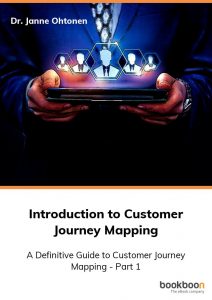7 essential components for your Customer Journey Map

 Customer Journeys are the modern version of customer processes. They describe how customers will travel from a desire to an outcome. If you want to put the customer at the heart of your business, ensuring long-term success, Customer Journey Mapping is something
Customer Journeys are the modern version of customer processes. They describe how customers will travel from a desire to an outcome. If you want to put the customer at the heart of your business, ensuring long-term success, Customer Journey Mapping is something
you will have to do to get there. Find out the essential components of a good Customer Journey Map.
Isn’t a good Customer Journey Map something that is entirely subjective? That’s true, depending on how you look at things. Luckily in a business context, we have already some borderlines, which can be used to narrow the definition of ‘greatness’ for Journey Maps. These could be things such as company values, objectives and strategies. It is worth the effort to assess, how they could affect the Journey Mapping initiative and requirements for it. Another angle is to think about the ‘fit for purpose’. What is it that you want to achieve with the Journey Map? The practical aspect is something to consider also: there is no point in making a map just for the sake of having it (this should not be a ‘tick the box’ exercise). The map should have some practical impact on the business and how it is conducted. An excellent Customer Journey Map gives insight that isn’t available before. Also, it should be used to improve the way the business serves its customers dramatically.
Let’s familiarise us with main components of an excellent Customer Journey Map: •
- Customer Journey Steps
- Customer Interactions
- Breakpoints, a.k.a. Employee Journey
- Business Rules and Decisions
- Systems and Tools
- Resources and Capabilities
- Stakeholders
- Emotional Journey
Each of the components is introduced in more details in the following sub-chapters. The greatness of any Customer Journey Map should be determined in the light of its fit for purpose for the organisation. Also, being able to take action based on the map to improve the business should be considered highly valuable. Customer Journey Map must contain at least Journey Steps to be called a Customer Journey Map. Other components in the map should all be aligned to the Journey Steps. Now, let’s discuss all these elements shortly in more detail.
Customer Journey
Let’s start with Customer Journey Steps, which are the most critical components of a map. The steps define the details of an end-to-end Journey the customer takes to achieve the desired outcome. One of the most common questions around this topic is about the right level of details for a Customer Journey Map. This comes back to the previously discussed matter of what you are using the map for. What you need to ask is “How much do we need to know, to know that we know enough?”, as someone once said. Any level of detail on the map have different uses for them. Higher level maps are useful for strategic work and lower level for more specific process and system work.
Employee Journeys
Breakpoints, or Employee Journeys, are the other side of a “touchpoint coin” (coins have two sides in them, same applies to journeys we are about to map). Breakpoints are all the internal handovers done in the organisation. This is where most of the mistakes affecting Customer Journey origin. It is also where the magic customer sees comes from. That depends on how well, consistently and reliably those internal handovers happen (or not). Hence the name Breakpoint. Examples of Breakpoints could be Mary asking John to take a cup of coffee to a customer’s table. Maybe John remembers to do it or perhaps not. It could also be a database administrator updating customer records. Or a boss asking an employee to do something.
Business Rules and Decisions
Business Rules and Decisions are a part of Customer Journey that affects its course consistently. To think of it, it is almost funny how many rules companies have that people are not even aware of. Some of them may be formally expressed, some not. It is crucial to know where these Business Rules origin from and whether they are still valid. Would it be too harsh to estimate that many of the Business Rules in your company are unknown, outdated or obsolete, also? Based on my empirical experience with many businesses, there is a good chance for that, at least. Example of a Business Rule is a situation where the customer has to pay an extra charge for using a credit card. Another example is when a customer is required to provide the company with three different proofs of address. The secret with Business Rules is not to evaluate whether they make sense for the business, but for the customer.
Systems and Tools
Systems and tools are an essential part of delivering customer experiences as part of a journey. If the employees have the right and efficient IT systems as well as tools available, it makes it easier to serve the customer. How many times has someone told you that they would love to help you, but they can’t because of the systems? That is an example of a situation, where the Systems and Tools have not been aligned with the Journey and the successful customer outcomes. Systems and Tools shape the journey through enabling and limiting what the organisation can do for the customer. To be more exact, it is the way these systems have been designed and implemented that limits us. This could also be through having underinvested in upgrading and improving these tools over time.
An excellent Customer Journey Map takes any relevant Systems and Tools into consideration. They can be mapped to each Journey Step and used to evaluate whether the current systems and tools are sufficient for ensuring smooth Customer Journeys. As an example, how many times have you visited a coffee shop that accepts only cash? It is very likely that they have not invested in appropriate systems to be able to take card payments.
Resources and Capabilities
You can map other resources and capabilities as part of the Customer Journey Map as it makes sense for your business. Highly specialised firms may especially benefit from mapping the critical resources. Examples of this kind of Resources or Capabilities could be social skills for handymen entering customer premises (their behaviour at the site is part of the journey as well as one crucial touchpoint). Also, mapping stakeholders can be useful for businesses where there is an extensive cross-departmental cooperation required to serve customer journeys. This will bring visible any potential gaps in collaboration and communication both internally and externally.
Emotional Journey
Customer Emotions are typically a less talked about a component in the Journey Maps. Still, they are one of the most important ones too (besides touchpoints). We people are emotional beings. We continuously have various feelings guiding us. Every Customer Journey evokes some emotions whether we wanted or not. Even not having any particular feelings in some situation is a feeling (replacing some other feeling the customer could have at that time with indifference). Why this is important for the Journey Mapping is because we want to understand and evoke desired Emotions instead of random ones. For example, Starbucks wants to make you feel like home when you go in. Apple invokes creative and significance feelings in their customers. Avios can give you a feeling of earning a holiday while doing everyday shopping. All these emotions are essential for the customers along their journey to reach the desired outcome.




